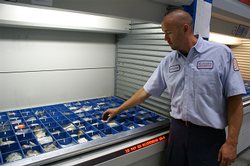
10 signs it’s time to rethink your intralogistics
Intralogistics – or the methods used to handle, store, track, locate and manage the inventory, parts, goods and items within the four walls of an operation – can have a significant impact on productivity. In facilities relying on traditional static shelving for storage of non-palletized items, the inherent limitations of the storage method itself can hamper associates’ ability to find the right item quickly and in its expected condition.
Here are ten signs your shelf-based intralogistics practices might be negatively impacting your operation.
1. Excessive replenishment
If reserve inventory of fast- and medium- moving items is stored in static shelving, time can be wasted waiting for replenishment of inventory.
2. Extensive pick travel
Often workers are traveling many miles during a shift; walking that translates into wasted time. In a manual operation – where workers must travel to the items – workers frequently spend as much as 60-65% of their shifts walking.
3. Wasted search time
Upon arrival at a picking destination, a worker must visually search the shelves, looking for the correct item and matching up part numbers, a process that can take several minutes or more.
4. Pick errors
Operators follow a paper pick list, travel to a location, find the item, check the list to determine the number of items required, pick the items, confirm the pick by marking the paper, then deliver the items for packing. Each step is an opportunity for human error.
5. Low throughput
In a manual operation, pickers often fill just one order at a time, translating into pick rates of approximately 50 lines per hour.
6. Damaged items
Goods stored on shelves, whether in or out of containers, are exposed to dirt and dust common to warehousing and manufacturing operations. This shortens their useful life and renders them unsuitable for sale or internal use.
7. Missing inventory
In open shelving spread across hundreds or thousands of square feet, items can simply get lost. It can be a challenge to know how many items are in stock, and their precise location.
8. Pilfered product
Open shelving is unsecured storage allowing anyone who passes by the opportunity for theft.
9. Wasted storage space
Traditional, static shelving not only requires a tremendous amount of floor space, it also does not make use of empty overhead (or vertical) space.
10. Improper ergonomics
Shelf-based storage forces workers to bend or stretch to reach inventory, or even use ladders to access the highest items. All of these activities can increase the chances of injury.
Self-contained automated storage and retrieval equipment options are available as alternative solutions to improving a facility’s intralogistics without requiring a major remodel. Three primary types include: vertical carousels, vertical lift modules (VLMs) and horizontal carousels. These high-density storage solutions significantly reduce the amount of square footage required to store inventory. For example, the equivalent amount of inventory held in 120 bays of static shelving can be condensed into two horizontal carousels (66% space savings), two vertical carousels (75% space savings) or a single VLM (85% space savings).
Facilities with multiple floor levels or mezzanines can optimize replenishment of vertical carousel or VLM by adding a second access opening at a different elevation. This allows one opening to be dedicated to replenishment and the other dedicated to picking. Speeding up picking also maximizes workers’ available time for other revenue generating activities. Using batching picking to group together orders with common items allows for picks to be completed in a single rotation (or cycle) of the unit. Batch picking can increase throughput by as much as 200% – up to 600 lines per hour.
Automated storage and retrieval technologies operate on the “goods to person” principle, delivering a required item directly to the operator. This dramatically reduces travel time, in addition to improved worker ergonomics. This eliminates the need to reach, bend or stretch for products stored at the top or bottom or static rack and shelving.
Integrated with light-directed picking and integrated message centers, these systems communicate the precise area within a carrier of the item to be picked, display the part number or description, pinpoint the exact location, direct picking and indicate the required quantity. These visual picking aids reduce processing errors and increase accuracy up to 99.9%.
Consider automated storage and retrieval systems to improve intralogitics processes, increase accuracy, save floor space and increase productivity.
Kardex Remstar, LLC, a company of the Kardex Group is a provider of automated storage and retrieval systems for manufacturing, distribution, warehousing, offices and institutions.









